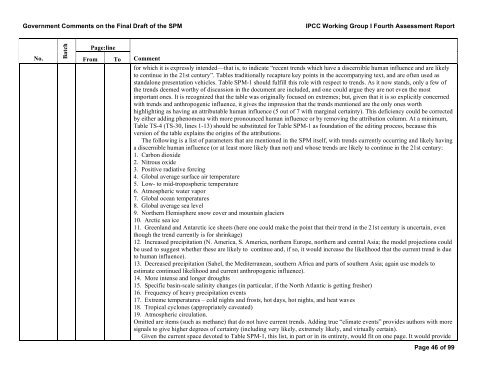Government Comments on the Final Draft of the SPM IPCC Working ...
Government Comments on the Final Draft of the SPM IPCC Working ...
Government Comments on the Final Draft of the SPM IPCC Working ...
Create successful ePaper yourself
Turn your PDF publications into a flip-book with our unique Google optimized e-Paper software.
<str<strong>on</strong>g>Government</str<strong>on</strong>g> <str<strong>on</strong>g>Comments</str<strong>on</strong>g> <strong>on</strong> <strong>the</strong> <strong>Final</strong> <strong>Draft</strong> <strong>of</strong> <strong>the</strong> <strong>SPM</strong><br />
<strong>IPCC</strong> <strong>Working</strong> Group I Fourth Assessment Report<br />
No.<br />
Batch<br />
Page:line<br />
From To Comment<br />
for which it is expressly intended—that is, to indicate “recent trends which have a discernible human influence and are likely<br />
to c<strong>on</strong>tinue in <strong>the</strong> 21st century”. Tables traditi<strong>on</strong>ally recapture key points in <strong>the</strong> accompanying text, and are <strong>of</strong>ten used as<br />
standal<strong>on</strong>e presentati<strong>on</strong> vehicles. Table <strong>SPM</strong>-1 should fulfill this role with respect to trends. As it now stands, <strong>on</strong>ly a few <strong>of</strong><br />
<strong>the</strong> trends deemed worthy <strong>of</strong> discussi<strong>on</strong> in <strong>the</strong> document are included, and <strong>on</strong>e could argue <strong>the</strong>y are not even <strong>the</strong> most<br />
important <strong>on</strong>es. It is recognized that <strong>the</strong> table was originally focused <strong>on</strong> extremes; but, given that it is so explicitly c<strong>on</strong>cerned<br />
with trends and anthropogenic influence, it gives <strong>the</strong> impressi<strong>on</strong> that <strong>the</strong> trends menti<strong>on</strong>ed are <strong>the</strong> <strong>on</strong>ly <strong>on</strong>es worth<br />
highlighting as having an attributable human influence (5 out <strong>of</strong> 7 with marginal certainty). This deficiency could be corrected<br />
by ei<strong>the</strong>r adding phenomena with more pr<strong>on</strong>ounced human influence or by removing <strong>the</strong> attributi<strong>on</strong> column. At a minimum,<br />
Table TS-4 (TS-30, lines 1-13) should be substituted for Table <strong>SPM</strong>-1 as foundati<strong>on</strong> <strong>of</strong> <strong>the</strong> editing process, because this<br />
versi<strong>on</strong> <strong>of</strong> <strong>the</strong> table explains <strong>the</strong> origins <strong>of</strong> <strong>the</strong> attributi<strong>on</strong>s.<br />
The following is a list <strong>of</strong> parameters that are menti<strong>on</strong>ed in <strong>the</strong> <strong>SPM</strong> itself, with trends currently occurring and likely having<br />
a discernible human influence (or at least more likely than not) and whose trends are likely to c<strong>on</strong>tinue in <strong>the</strong> 21st century:<br />
1. Carb<strong>on</strong> dioxide<br />
2. Nitrous oxide<br />
3. Positive radiative forcing<br />
4. Global average surface air temperature<br />
5. Low- to mid-tropospheric temperature<br />
6. Atmospheric water vapor<br />
7. Global ocean temperatures<br />
8. Global average sea level<br />
9. Nor<strong>the</strong>rn Hemisphere snow cover and mountain glaciers<br />
10. Arctic sea ice<br />
11. Greenland and Antarctic ice sheets (here <strong>on</strong>e could make <strong>the</strong> point that <strong>the</strong>ir trend in <strong>the</strong> 21st century is uncertain, even<br />
though <strong>the</strong> trend currently is for shrinkage)<br />
12. Increased precipitati<strong>on</strong> (N. America, S. America, nor<strong>the</strong>rn Europe, nor<strong>the</strong>rn and central Asia; <strong>the</strong> model projecti<strong>on</strong>s could<br />
be used to suggest whe<strong>the</strong>r <strong>the</strong>se are likely to c<strong>on</strong>tinue and, if so, it would increase <strong>the</strong> likelihood that <strong>the</strong> current trend is due<br />
to human influence).<br />
13. Decreased precipitati<strong>on</strong> (Sahel, <strong>the</strong> Mediterranean, sou<strong>the</strong>rn Africa and parts <strong>of</strong> sou<strong>the</strong>rn Asia; again use models to<br />
estimate c<strong>on</strong>tinued likelihood and current anthropogenic influence).<br />
14. More intense and l<strong>on</strong>ger droughts<br />
15. Specific basin-scale salinity changes (in particular, if <strong>the</strong> North Atlantic is getting fresher)<br />
16. Frequency <strong>of</strong> heavy precipitati<strong>on</strong> events<br />
17. Extreme temperatures – cold nights and frosts, hot days, hot nights, and heat waves<br />
18. Tropical cycl<strong>on</strong>es (appropriately caveated)<br />
19. Atmospheric circulati<strong>on</strong>.<br />
Omitted are items (such as methane) that do not have current trends. Adding true “climate events” provides authors with more<br />
signals to give higher degrees <strong>of</strong> certainty (including very likely, extremely likely, and virtually certain).<br />
Given <strong>the</strong> current space devoted to Table <strong>SPM</strong>-1, this list, in part or in its entirety, would fit <strong>on</strong> <strong>on</strong>e page. It would provide<br />
Page 46 <strong>of</strong> 99

















